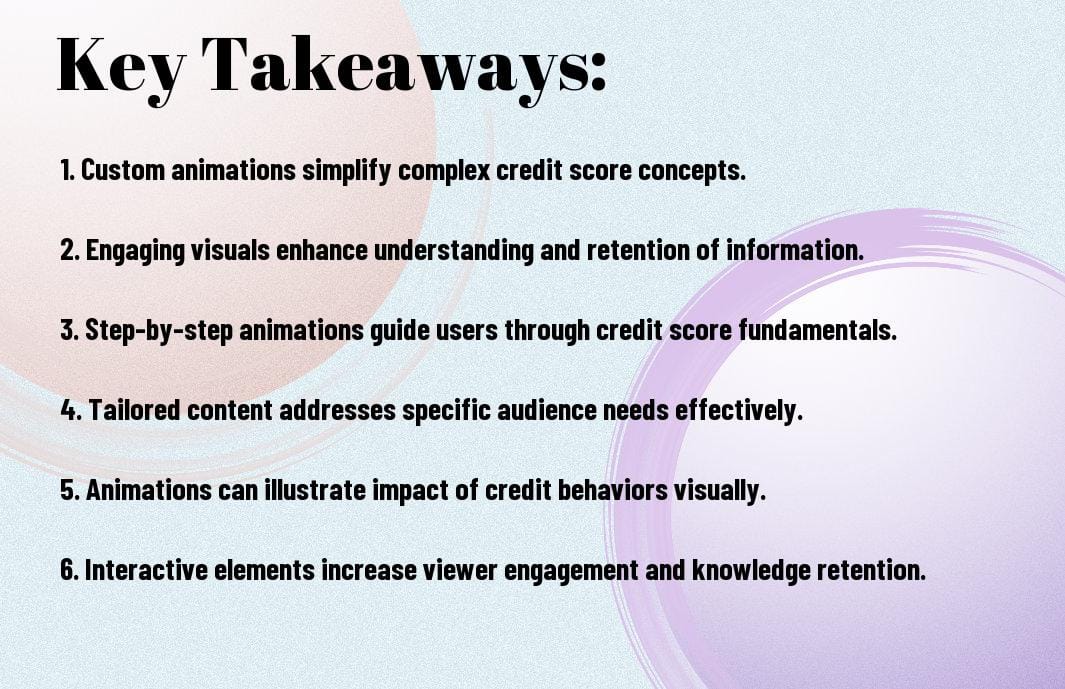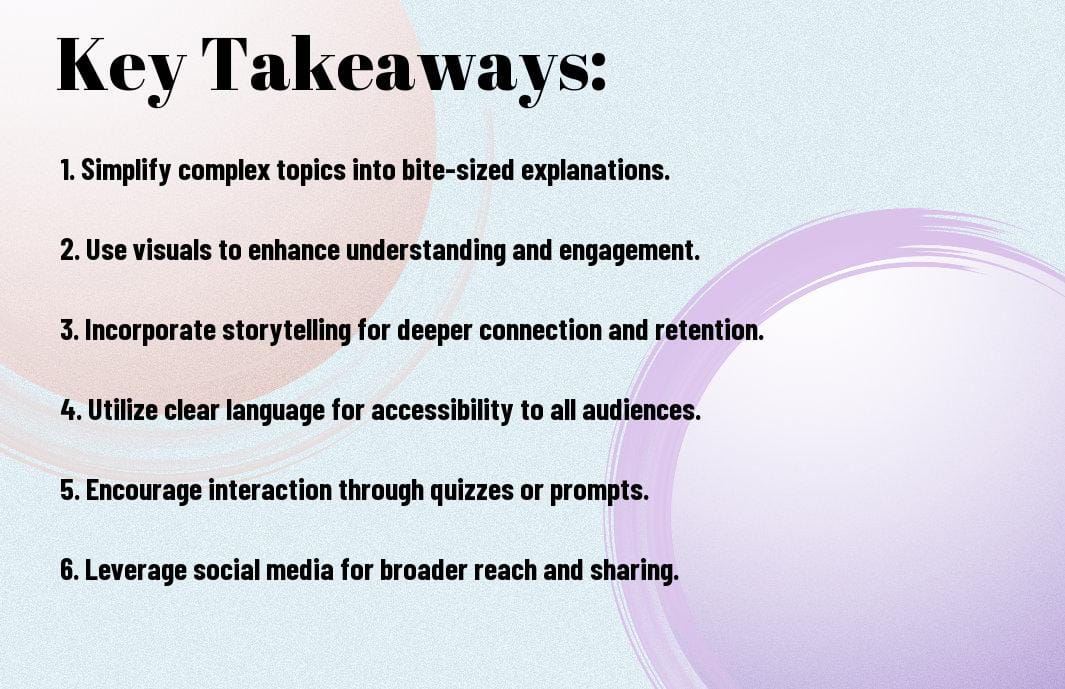
by Candido | Dec 17, 2024 | Finance
Many people underestimate the power of animated financial content in the digital landscape. By 2025, you’ll see how this engaging medium can transform your understanding of finance and investment like never before. As you embrace innovative storytelling techniques, you’ll discover how animation enhances retention and emotional connection. Get ready to leverage cutting-edge technology and stay ahead of the curve, as the future of finance becomes more visual, interactive, and accessible. This is your opportunity to tap into trends that will not only captivate but also empower you.

Key Takeaways:
- Interactivity: Animated financial content will increasingly incorporate interactive elements, allowing users to engage in personalized learning experiences.
- Personalization: Advanced AI algorithms will tailor animations based on individual financial knowledge and goals, making content more relevant and impactful.
- Augmented Reality: The use of AR technologies will enhance the visualization of financial concepts, providing immersive experiences that simplify complex information.

The Rise of Interactive Financial Animations
The future is buzzing with excitement over interactive financial animations. As we move toward 2025, you’re going to see these tools revolutionize how you present and interact with your financial data. Instead of just passive viewing, your audience will want to engage, manipulate, and dive deep into the numbers that matter. Want to know why this is happening? Because people crave involvement—whether it’s clicking buttons, dragging assets around, or playing simulations that let them control the outcome. This kind of content makes your complex data not only digestible but downright enjoyable.
You can position yourself to ride this wave by investing in these innovative animations. The future isn’t just about feeding your audience information; it’s about crafting experiences that resonate. You can use this trend as a differentiator in your marketing strategy. For a deeper look into the context of this shift, check out the Top Animation Trends to Watch in 2025 for Business Owners. It’s not just about presenting figures anymore; it’s about creating an interactive journey that empowers your audience to understand and appreciate your financial insights like never before. Lean into this change, and you’ll ensure not only visibility but a stronger connection with your audience. Let’s get it going!
Personalized Financial Content for Millennial and Gen Z Investors
While you’re navigating the complex world of investing, personalization is going to be your superpower by 2025. It’s no secret that Millennial and Gen Z investors want content that speaks directly to them—their values, their lifestyle, and their financial goals. This means no longer settling for generic advice; you’ll find yourself bombarded with tailored financial insights that resonate with your unique situation. Picture this: AI-driven platforms delivering updates, tips, and strategies specifically designed for your spending habits or investment interests. You’re not just a number; you’re a dynamic individual shaping your financial landscape.
However, you have to be cautious about the information overload that could come with this personalization factor. With so many sources providing tailored content, it’s easy to get swept away by flashy trends that may not align with your actual financial strategies. Yet, fear not! Amidst the noise, the best personalization will empower you to make smarter, more informed choices, helping you achieve your financial freedom fast. Make sure you engage with platforms that prioritize authenticity and deliver data-driven insights while ensuring your financial health is at the forefront of their mission.
AI and Machine Learning in Animation Creation
There’s a revolution happening right before your eyes, and if you want to stay ahead of the curve in 2025, you need to embrace it. AI and machine learning are not just buzzwords; they’re game-changers in animated financial content. Imagine tools that analyze your audience’s behavior in real-time, adjust animations dynamically, and create tailored experiences just for them. This means you can deliver the most engaging financial insights while keeping your brand fresh and innovative. Talk about upping your content game!
But let’s not kid ourselves; with great power comes great responsibility. You have to be aware of the ethical implications of using AI in animation. The balance between automation and maintaining a personal touch is vital. Sure, the instant modifications and data-driven designs are enticing, but you can’t lose the authenticity that connects you to your audience. Harnessing these tools smartly ensures that you can provide invaluable insights wrapped in attention-grabbing visuals, setting you apart from the noise in the financial sector.

The Role of Social Media in Financial Education
If you think about it, social media is changing the way people absorb financial education at an astonishing pace. Platforms like TikTok, Instagram, and YouTube are not just for cat videos anymore; they’re buzzing with financial advice that’s digestible and engaging. You have an incredible opportunity to leverage these platforms to not only learn but also share insights about money management, investing, and budgeting. The *visual* appeal of animated financial content makes complex concepts easier to grasp, and when you pair that with the viral nature of social media, the potential for impact is massive. You can tap into this wave, positioning yourself as a knowledgeable source in the space—or simply as someone who’s smart enough to seek out the right advice.
However, with this power comes great responsibility. The dangerous side of social media is that misinformation spreads just as quickly as the right guidance. It’s on you to discern what’s legitimate and what’s clickbait. Utilize your critical thinking skills and let your voice be part of the conversation that encourages transparency and accountability in financial education. The positive impact here is twofold: not only do you elevate your own financial literacy, but you also empower your community by sharing validated, well-researched content. Get in there and make waves while keeping your ethical compass intact—your future self will thank you.
Gamification of Financial Concepts
Some of the most exciting innovations around financial literacy are going to come from the gamification of financial concepts. This trend allows you to engage with your finances in a way that feels less intimidating and more like playing your favorite video game. Imagine unlocking achievements for saving money, leveling up your investment skills, or even competing with friends on who can build the best financial strategy. It’s all about transforming complex topics into engaging experiences that motivate you to take action. By turning finance into a game, you’re not just learning; you’re actively participating in your financial journey. How cool is that?
As you look to the future, think about how these playful approaches can make a lasting impact on your financial habits. With tools and platforms increasingly focusing on user experience, you’ll see more personalized and immersive financial education popping up everywhere. You can easily check out The Evolution and Future of Motion Design: A 2025 … for some fresh insights. This isn’t just about learning; it’s about fostering a healthy relationship with money, breaking down barriers, and putting your financial future in your hands. Your financial literacy will become a game, and the best part? You won’t even realize you’re leveling up your skills!
Sustainability in Animated Financial Storytelling
Even as the world grapples with the pressing challenges of climate change and ecological responsibility, you have an incredible opportunity to harness the power of animated financial storytelling to promote sustainability. By integrating concepts of green finance and responsible investing into your content, you can drive awareness and inspire action. It’s not just about numbers anymore; it’s about creating a narrative that resonates with a socially conscious audience. When you showcase brands that prioritize sustainable practices or tell stories about financial strategies that support environmental initiatives, you position yourself at the forefront of a movement. This approach not only builds trust but also fosters deeper connections with your audience.
Your animated financial narratives can reflect a future where profit and planet go hand in hand. As you plan for 2025 Animation Forecast: Trends That Will Transform the …, consider how you can use animation to illustrate the impact of investments on sustainability initiatives. Highlighting real success stories or depicting potential outcomes can empower your viewers to make informed financial decisions that align with their values. Embrace the responsibility to educate and inform, and you’ll not only captivate your audience but also become a beacon for those yearning for change. This is where your creativity can make waves in the finance landscape, so let’s drive this narrative forward!
Final Words
With these considerations, you need to embrace the future of animated financial content, as it’s not just a trend; it’s where your audience is heading. By 2025, you will see technology and creativity merge like never before, creating an engaging platform that allows your audience to not only absorb financial concepts but be excited about them. Think interactive animations, personalized content, and viral storytelling as the cornerstones of your strategy. Dive into the world of virtual reality and augmented reality, because viewers are ready for an experience that goes beyond a basic infographic. It’s time to shake things up and ensure that financial education isn’t just informative but downright entertaining.
This isn’t just a play for the future; it’s a massive opportunity to resonate with a younger audience hungry for knowledge and engagement. You have to be in the game, adapting your approach as trends evolve. By aligning your animation strategies with the fast-paced digital landscape of 2025, you’ll position yourself as a pioneer in the field. So gear up, get creative, and make financial content that not only informs but also inspires. The future is yours to mold, and if you play your cards right, you won’t just capture attention; you’ll keep it for good.
FAQ
Q: What will be the role of artificial intelligence in animated financial content by 2025?
A: By 2025, artificial intelligence is expected to play a significant role in creating personalized animated financial content. AI will analyze user data to tailor animations that address individual financial needs and learning styles, making the content more engaging and accessible. Additionally, AI can assist in automating the production process, enabling the rapid creation of customized animations based on current market trends and individual portfolios.
Q: How will advancements in technology impact the quality of animated financial content?
A: Advancements in technology, particularly in animation software and rendering capabilities, will greatly enhance the quality of animated financial content by 2025. Enhanced graphics and faster rendering processes will allow creators to produce more visually appealing and detailed animations. Moreover, interactive elements, such as 3D visualizations and AR/VR experiences, will become more common, offering viewers a more immersive and informative understanding of complex financial concepts.
Q: What trends are expected in the distribution of animated financial content by 2025?
A: By 2025, we can expect a shift towards multi-platform distribution of animated financial content. Social media, mobile apps, and streaming platforms will continue to be vital channels for reaching audiences. Animated financial content will increasingly leverage short-form videos for social media marketing while offering deeper dives on dedicated educational platforms. This trend will allow creators to engage various demographics, catering to both casual viewers and those seeking in-depth financial education.
Q: How will audience engagement methods change for animated financial content in the coming years?
A: Audience engagement methods for animated financial content will evolve significantly by 2025. Interactive and gamified elements will become more prevalent, encouraging viewers to actively participate in learning rather than passively consuming content. Additionally, incorporating feedback mechanisms will allow creators to adapt their content based on viewer preferences. Live Q&A sessions or webinars following animated content releases will help in fostering community interactions and providing real-time financial advice.
Q: What will be the focus of animated financial content in terms of subject matter by 2025?
A: By 2025, animated financial content is expected to focus on a broad range of subject matter, including sustainability, ethical investing, and the impact of emerging technologies like blockchain and cryptocurrencies. As more audiences become interested in socially responsible investing and innovative financial practices, creators will adapt their content to highlight these trends. Additionally, educational content aimed at promoting financial literacy among younger audiences will be prioritized, ensuring that foundational financial concepts are effectively conveyed.

by Candido | Nov 28, 2024 | Finance
Scores play a vital role in your financial journey, influencing your ability to secure loans, credit cards, and even housing. With the help of custom animation services, you can easily grasp the complexities of credit scores and how they affect your financial decisions. This guide offers you a step-by-step approach to understanding your credit score, highlighting both the positive impacts of maintaining a good score and the risks associated with a low score. Let’s dive in and empower you to take control of your credit health!
Key Takeaways:
- Custom Animation Services enhance comprehension of complex topics like credit scores, making it easier for viewers to grasp the material.
- Step-by-Step Approach breaks down information into manageable parts, fostering a clear understanding of the factors that affect credit scores.
- Engagement through visual storytelling increases retention, allowing viewers to better recall and apply knowledge about credit scores in their financial decisions.
What is a Credit Score?
For individuals seeking to understand their financial health, a credit score serves as a vital metric. It reflects your creditworthiness based on your financial behavior, including how responsibly you manage debt. A better understanding of credit scores can empower you to make informed financial decisions and access better loan options.
Definition and Importance
The credit score is a numerical representation of your credit health, typically ranging from 300 to 850. A higher score indicates lower risk to lenders, making it vital for loan approval, favorable interest rates, and renting properties. Your score influences significant financial decisions throughout your life.
Factors Influencing Credit Scores
One major aspect that affects your credit score includes:
- Payment History
- Credit Utilization
- Length of Credit History
- Types of Credit
- New Credit Inquiries
Assume that understanding these factors helps you maintain or improve your score, enabling better financial opportunities.
Further analyzing each factor provides greater clarity on how to manage your credit effectively. Your payment history holds substantial weight as late payments significantly impact your score. Additionally, maintaining a low credit utilization ratio demonstrates responsible credit usage. The longer your credit history, the better it reflects on your score, whilst having diverse types of credit can boost it. Lastly, too many new credit inquiries can signify risk. Assume that a balanced approach toward these elements maximizes your credit score potential.

The Role of Animation in Financial Education
Some may underestimate the power of animation in financial education, but it serves as an effective tool for simplifying complex topics. By utilizing MyCredit Guide FICO® Score & Experian® Credit Report, you can learn about your credit score in a way that feels engaging and accessible. Animation can make the learning process more enjoyable and retainable, ultimately helping you make informed financial decisions.
Enhancing Understanding
Enhancing your grasp on financial concepts is easier with animation. This medium breaks down intricate information into digestible segments, allowing you to absorb and comprehend details about your credit score and its impact on your financial health.
Engaging Visuals
Enhancing your financial education experience is largely due to engaging visuals that animation provides. You’ll find that colorful images, interesting characters, and lively sequences capture your attention, making learning about credit scores less intimidating.
This dynamic approach not only captures your interest but helps you relate to the content. By illustrating scenarios like how timely bill payments can improve your credit score, or how late payments can negatively affect it, you gain a visual representation of the positive and negative consequences of your financial behaviors. Such clear depictions help you connect your actions to their repercussions, making it easier to navigate your financial journey.
Benefits of Custom Animation Services
Once again, leveraging custom animation services offers numerous advantages for explaining complex concepts. These animations not only facilitate understanding but also make learning enjoyable and engaging. By utilizing visual storytelling, you can effectively capture your audience’s attention, translating intricate financial principles into memorable and relatable narratives that resonate with your viewers.
Tailored Content
Before submerging into custom animation, consider how it allows for the creation of tailored content that speaks directly to your audience’s needs. You can outline your key messages and convey them in a way that aligns with your viewers’ interests, ensuring they receive information that is relevant and engaging.
Improved Retention
On the flip side, custom animations significantly boost information retention. By presenting your content visually, you help create a multi-sensory learning experience that is easier for your audience to grasp and remember.
For instance, studies have shown that people are more likely to recall information presented in an animated format. This approach leverages visual elements and storytelling techniques, which enhance cognitive processing, allowing you to effectively communicate even complex ideas. By incorporating engaging animations, you not only increase the chances that your audience will retain vital information about credit scores but also foster a deeper understanding of their significance in financial health. This leads to greater confidence and informed decision-making regarding their credit journeys.

Step-by-Step Process to Create Animated Content
All aspects of creating animated content involve thoughtful planning and execution. You should understand each phase to ensure your message about How Is My Credit Score Calculated? is effectively conveyed. Below is a summary of the important steps involved:
| Step |
Description |
| 1 |
Concept Development |
| 2 |
Storyboarding and Design |
Concept Development
Any project starts with concept development, where you refine your ideas into a clear message. This phase is critical as it sets the foundation for your animation. Discuss your goals and the target audience, focusing on making the complex topic of credit scores relatable and engaging.
Storyboarding and Design
Between concept development and final animation, storyboarding and design play a significant role. You sketch the animation sequence, visualize scenes, and ensure that your narrative flows smoothly. This stage transforms your ideas into a detailed plan, incorporating visuals that complement your message.
Also, this phase allows you to assess the visual style, color palette, and animation techniques best suited for your audience. Make choices that reflect your brand while ensuring the content remains accessible. By blending creativity with strategic design, you can effectively communicate the positive and negative aspects of credit scores while engaging viewers.

Using Animation to Explain Credit Scores
Many people find credit scores to be an intricate and confusing topic. However, using animation can effectively demystify the subject, helping you understand the key components that influence your creditworthiness. With visually engaging content, you can grasp how factors such as payment history, credit utilization, and length of credit history impact your score, all in a way that is easy to digest and retain.
Simplifying Complex Information
Beside providing entertainment, animation serves as a powerful tool for simplifying complex information. By breaking down difficult concepts into bite-sized, visually appealing segments, you can more easily understand how various elements contribute to your credit score. This clarity empowers you to make informed decisions regarding your financial health.
Real-World Applications
At the same time, animation demonstrates real-world applications of credit scores in your everyday life. From obtaining loans to understanding interest rates, your credit score plays a significant role in financial transactions. Visual representations can help you foresee how your actions affect your score, allowing for proactive management.
Scores have a direct effect on your financial opportunities, influencing decisions like loan approvals, interest rates, and even job applications. By using animated content to represent these real-world scenarios, you can visualize how a good credit score opens doors, while a poor one can limit your options. Through animation, you gain insight into strategies for maintaining or improving your score, such as timely bill payments and managing credit card balances. Ultimately, this understanding enables you to navigate your financial landscape with confidence.
Measuring the Effectiveness of Animation for Learning
After implementing custom animation services to illustrate credit scores, you should evaluate their effectiveness in enhancing comprehension and retention. Animated content can make complex information more digestible, helping you visualize and better understand critical concepts surrounding credit scores. Regular assessments allow you to gauge learner engagement and knowledge acquisition, ensuring you are on the right educational track.
Feedback and Assessment
On collecting feedback from your audience, you will gain invaluable insights into how well they grasp the animated content. Surveys, quizzes, and discussions can provide qualitative and quantitative data that highlight areas of success and those that may require improvement. This feedback loop is crucial for tailoring your animations to meet learner needs.
Adjusting Strategies
Across your evaluations, you might discover particular themes or topics where learners struggle or excel. It’s crucial to adapt your content and delivery strategies based on this feedback, optimizing future animations to target identified gaps in understanding.
Further, leveraging adjustments not only improves your current animations but also ensures that your future projects remain relevant and effective. You might consider revising visuals or simplifying explanations for complex topics that receive lower comprehension scores. Additionally, integrating interactive elements can enhance engagement, making learning more effective. By continuously refining your approach, you foster a learning environment that accommodates your audience’s needs, ultimately leading to better knowledge retention.

Final Words
Conclusively, understanding credit scores is necessary for managing your financial health effectively. Utilizing custom animation services can enhance your grasp of the intricacies involved in credit reporting and scoring. This engaging approach enables you to visualize complex concepts, making them easier to understand. For further insights on improving your credit, consider exploring How to Build Credit With and Without a Credit Card. Empower yourself with knowledge to foster better financial decisions.
FAQ
Q: What are credit scores and why are they important?
A: Credit scores are numerical representations of a person’s creditworthiness based on their credit history, including borrowing and repayment behaviors. They typically range from 300 to 850, with higher scores indicating better credit health. Credit scores are important as they influence loan approvals, interest rates, and rental agreements, impacting an individual’s financial opportunities and decisions.
Q: How can custom animation services help in understanding credit scores?
A: Custom animation services can simplify complex financial concepts like credit scores through engaging visual storytelling. By using animations, these services can break down terminology, illustrate the factors affecting credit scores, and present real-life scenarios. This approach not only makes the information more approachable but also retains attention and enhances retention compared to traditional text-heavy presentations.
Q: What steps should I take to improve my credit score as shown in the animation?
A: Improving your credit score involves several actionable steps showcased in the animated guide. Key steps include consistently paying bills on time, reducing credit card balances, avoiding new hard inquiries into your credit, and regularly monitoring your credit report for errors. Each of these strategies is depicted with examples in the animation to help viewers visualize and understand how they can make positive changes to their credit behavior.

by Candido | Nov 22, 2024 | Finance
It’s time to unlock the potential of animated explainer videos to simplify the often complex world of student loans. In this guide, you’ll discover 10 necessary steps that will help you create engaging and informative content that resonates with your audience. Whether you’re a student aiming to understand your financial options or an educator looking to spread awareness, these techniques will empower you to convey important information while keeping your viewers captivated. Get ready to turn confusion into clarity!

Key Takeaways:
- Storytelling is vital: Engaging narratives help to clarify complex topics like student loans and keep viewers interested.
- Visual Elements enhance understanding: Utilizing animations and graphics can simplify the explanation of difficult concepts and make learning more enjoyable.
- Clear Call-to-Action: Conclude with a strong message or directive that encourages viewers to take the next step in managing their student loans effectively.
Understanding Student Loans
Your journey into student loans begins with grasping the important concepts surrounding them. To better navigate your financial future, consider exploring 15 Best Financial Services Explainer Videos That Greatly … that can clarify these intricacies.
Types of Student Loans
One way to categorize student loans is by understanding their different types:
| 1. Federal Loans |
Government-funded loans with fixed rates. |
| 2. Private Loans |
Loans from private institutions, with varying rates. |
| 3. Subsidized Loans |
Interest is paid by the government while in school. |
| 4. Unsubsidized Loans |
You are responsible for all interest accrued. |
| 5. PLUS Loans |
Loans for parents and graduate students, often requiring credit checks. |
After exploring these categories, you’ll have a clearer understanding of your options.
Loan Terminology Explained
Behind every loan are terms that impact your financial decisions. Familiarizing yourself with loan terminology ensures wiser choices in repayment.
Loan terms such as credit score, which reflects your creditworthiness, and interest rate, determining the cost of borrowing, are vital. Additionally, principal refers to the amount borrowed, while loan term is the duration over which you repay the loan. Adequately grasping these terms can help you avoid costly mistakes and make informed financial decisions.
Animation Basics for Explainer Videos
Clearly, understanding the fundamentals of animation is important for creating compelling explainer videos. By grasping the basics, you can effectively communicate your message while engaging your audience. For guidance on utilizing videos to enhance your business, check out How to use educational videos to grow your business.
Key Animation Principles
Along with creativity, mastering key animation principles helps you craft stories that resonate with viewers. Principles like timing, spacing, and anticipation enhance the clarity and impact of your message. Applying these concepts will elevate your animations, making them not only visually appealing but also effective in conveying your ideas.
Tools and Software for Animation
Before plunging into your animated explainer video, it’s vital to choose the right tools and software. There are plenty of options available, ranging from beginner-friendly platforms to professional-grade programs, allowing you to pick the best fit for your needs.
Indeed, selecting the appropriate animation tools can greatly influence your project’s success. User-friendly solutions like Vyond and Powtoon are excellent for quick and effective animations, while software like Adobe After Effects offers advanced features for more experienced users. Your choice will depend on your skills, budget, and the complexity of the video you want to produce.
Storyboarding Your Explainer Video
Once again, storyboarding is a decisive phase in creating effective animated explainer videos. This step allows you to visualize the flow of your narrative and set the groundwork for the entire project. For added inspiration, check out How Industries Can Use Explainer Videos (With Examples).
Importance of a Solid Script
An effective explainer video begins with a solid script that defines your message. The script serves as the backbone, guiding the visuals and pacing while ensuring clarity and engagement for your audience. Focus on delivering your core message succinctly and persuasively.
Creating a Visual Flow
Along your storyboarding journey, creating a visual flow is necessary to maintain coherence and engagement in your explainer video. Your storyboard should outline the sequence of scenes, ensuring that each frame effectively transitions to the next. This allows viewers to follow your narrative without confusion.
Also, consider integrating visual metaphors and consistent imagery to reinforce your message and keep the audience engaged. A seamless flow means utilizing transitions that connect different sections while maintaining your video’s overall tone. By balancing visual elements with your script, you’ll enhance understanding and retention of the information you’re sharing.

Designing Engaging Characters and Scenes
Many successful animated explainer videos rely on captivating characters and vivid scenes to keep viewers engaged. When crafting your animation, focus on creating relatable characters and visually appealing environments that draw your audience in. This element can significantly enhance the storytelling aspect, making complex information like student loans easier to digest and comprehend. By combining creativity with clarity, you can create a memorable experience that resonates with your audience.
Character Development
Characters play a vital role in connecting with your audience. When developing your characters, ensure they are relatable and reflect the diversity and challenges faced by your viewers. By giving your characters unique traits and emotional depth, you can foster empathy and engagement, allowing your audience to see themselves in the journey of learning about student loans.
Visual Style and Branding
Among the key elements of your animated video is the visual style and branding, which sets the overall tone and identity. Your visual aesthetic should align with your brand message and audience preferences, ensuring a cohesive experience. Utilizing colors, typography, and graphic styles that resonate with your target demographic allows you to establish a distinct personality for your animation.
At the outset of your project, focus on creating a strong visual identity that complements your message. Incorporate consistent color schemes and design elements that reflect your brand values. This attention to detail helps maintain audience interest and strengthens brand recognition. As you convey important information, like the intricacies of student loans, your visuals should enhance understanding, making it easier for viewers to grasp concepts and remember crucial details.
Voiceover and Sound Design
After creating a visually engaging animated explainer video, the next step is to enhance it with effective voiceover and sound design. These elements play a vital role in delivering your message clearly and maintaining the viewer’s attention. Selecting the right voiceover artist and incorporating fitting background music can elevate your video, ensuring that it resonates with your audience and reinforces the main ideas you wish to convey.
Selecting the Right Voiceover Artist
Against hiring just anyone, take the time to choose a voiceover artist whose tone and style align with your brand’s message. Look for someone who can convey emotions authentically and engage your audience effectively. Assess their previous work and consider conducting auditions to find a voice that not only sounds professional but also connects with your target demographic.
Incorporating Background Music and Effects
Music plays a significant role in shaping the mood of your explainer video. It enhances the emotional engagement of your audience and can significantly boost the impact of your message. Choose background music that complements the tone of your content while ensuring it doesn’t overpower the voiceover. Adding sound effects at pivotal moments can further emphasize key points and enrich the viewing experience.
Sound is a powerful tool in your animated video, as it can evoke emotions and guide viewers’ reactions. Choose background tracks that align with your video’s message and ensure that they are not too distracting. Also, consider using sound effects strategically to highlight important moments, drawing attention to your key messages. Balancing these elements will result in a more engaging, cohesive, and memorable explainer video.

Editing Your Animated Video
Keep your audience engaged by focusing on the quality of your video during the editing process. This stage allows you to refine your message, correct any errors, and enhance the visual appeal of your animated explainer video. Prioritize clear visuals and crisp audio to ensure your content stands out.
Tips for Effective Video Editing
Effective editing can make or break your animated video. Here are some tips to guide you:
- Prioritize clarity in visuals and message delivery.
- Ensure smooth transitions to maintain flow.
- Use sound effects and music thoughtfully for enhanced engagement.
- Keep it concise to hold viewer attention.
- Review and revise multiple times before finalizing.
Any attention to these elements will dramatically improve your video’s effectiveness.
Common Mistakes to Avoid
On your journey to perfect your animated explainer video, be vigilant about avoiding common pitfalls. You might underestimate the importance of planning your edits, leading to a disorganized final product. Moreover, neglecting audio quality can distract from the visuals, while overuse of effects can overwhelm your audience. It’s imperative to ensure that your video maintains a clear narrative structure and that your edits support the message rather than obscure it. The key is to keep it simple and focused, paying special attention to pacing and consistency throughout the video. By steering clear of these mistakes, you will create a more polished and professional result that resonates with your viewers.

Conclusion
Hence, by following these 10 steps to create effective animated explainer videos, you can simplify the complexities of student loans for your audience. With engaging visuals and clear narratives, you empower viewers to make informed decisions about their financial futures. Embrace this opportunity to connect with your audience, enhance their understanding, and ultimately guide them toward sensible loan management.
Q: What are the key benefits of using animated explainer videos for student loan education?
A: Animated explainer videos are an excellent tool for educating students about the complexities of student loans. They simplify intricate topics by breaking them down into bite-sized information, making it easier to understand concepts such as interest rates, loan types, and repayment plans. Additionally, the visual and auditory elements keep viewers engaged, enhancing retention of important details. These videos cater to various learning styles, ensuring a wider reach among students. Overall, they create a more user-friendly experience that aids in informed decision-making.
Q: How can I effectively script a student loan explainer video?
A: Effective scripting for a student loan explainer video involves several steps. Begin by defining your target audience and identifying their specific concerns about student loans. Next, outline the main points you want to cover, such as loan types, application processes, repayment strategies, and common pitfalls. Use a clear and conversational tone throughout the script to make the information relatable. Incorporate engaging stories or scenarios that resonate with students’ experiences. Lastly, keep the script concise to maintain viewer focus, ideally aiming for a length of around 1-3 minutes to ensure clarity without overwhelming the audience.
Q: What should I consider when choosing visuals for my animated explainer video on student loans?
A: When choosing visuals for your animated explainer video, aim for imagery that complements the narrative and reinforces the content. Use vibrant and relevant graphics that capture attention while being easy to understand. Consider employing metaphors, such as a journey or path, to symbolize the student loan process, allowing for greater connection with the audience. Ensure that the visual style matches your branding and resonates with your target demographic. Lastly, maintain consistency in color schemes, fonts, and animations to create a polished and professional appearance that enhances credibility.

by Candido | Nov 13, 2024 | Finance
Finance can often feel overwhelming, especially when faced with complex investment products. However, animated content offers a dynamic way to clarify intricate financial concepts for you and your clients. By utilizing visual storytelling, animations can break down complicated information into digestible segments, making it easier for your audience to understand and engage with your offerings. In this blog post, you’ll discover how animated content can enhance comprehension, foster trust, and ultimately simplify the investment journey for your customers.
The Role of Animation in Financial Education
Your understanding of financial products is imperative for making informed decisions. Animation serves as a powerful tool in financial education, breaking down complex concepts into digestible and engaging narratives. By utilizing visually compelling content, financial institutions can enhance your learning experience while demystifying intricate investment strategies.
Enhancing Comprehension Through Visuals
About 65% of individuals are visual learners, which implies that visuals are pivotal in effectively conveying financial concepts. Animated content can simplify abstract ideas, making them accessible and relatable. With engaging graphics and storytelling elements, animations can present financial data and investment scenarios in a way that resonates with your understanding.
Engaging Diverse Audiences
Education in finance is not one-size-fits-all. This means that different demographics have unique preferences and learning styles. By utilizing animation, you can cater to a range of audiences, from millennials to retirees, each with varying levels of financial literacy. Animated content allows financial institutions to tailor messages effectively, ensuring that imperative information is conveyed in an inviting manner that captivates users from all backgrounds.
This flexibility in presentation ensures that you can easily grasp the nuances of investment products, regardless of your prior knowledge. Whether through colorful infographics or dynamic storytelling, engaging animation can make complex financial topics more approachable. By addressing the diverse preferences of your audience, financial institutions not only increase the likelihood of comprehension but also foster a deeper connection with their clients.
Breakdown of Complex Investment Products
Assuming you are navigating the intricacies of investment products, understanding their components is vital. Complex financial instruments, such as derivatives or structured products, often involve multifaceted features and risks. By breaking these components into digestible parts, animated content can provide visual representations that simplify concepts like risk-return profiles, asset allocations, and market behavior, making it easier for you to grasp the foundational elements of each investment.
Simplifying Terminology with Animation
By using animation, you can transform complicated financial jargon into relatable visuals. Animated videos can pair terminologies with graphics that illustrate their meanings, making it easier for you to comprehend terms like dividend yields, volatility, and liquidity. This method not only clarifies the language but also provides an engaging way to retain the information.
Using Storytelling to Illustrate Concepts
Complex financial products can often seem overwhelming, but storytelling can make them more approachable. By framing investment scenarios within narratives, you can relate personal experiences to abstract financial concepts. This method encourages you to link financial principles to real-world situations, turning theoretical knowledge into practical understanding.
Breakdown of these concepts through storytelling can also involve presenting case studies of successful investments or cautionary tales of missteps. These narratives help contextualize investment principles and showcase the impacts of various decisions. By framing your learning in a story-like manner, you find it easier to visualize outcomes, ultimately making the complexities of finance more relatable and clearer to you.
Case Studies of Successful Animated Financial Content
You can explore how different financial institutions have effectively used animated content to demystify complex investment products.
- Vanguard: Increased engagement by 40% through short animations simplifying mutual funds.
- Fidelity: Over 500,000 views on their animated series explaining retirement accounts, leading to a 30% uptick in account sign-ups.
- Charles Schwab: Saw a 25% higher retention rate among viewers of their animated investment tutorials.
- Goldman Sachs: Increased social media shares by 150% after launching an animated overview of their investment strategies. Learn more about their strategy.
Examples from Leading Financial Institutions
Content from top firms like Morgan Stanley and JP Morgan illustrates how animated videos can clarify complex financial concepts. By depicting intricate graphs and scenarios, they help clients visualize investment strategies, making it easier to grasp crucial details.
Analyzing Viewer Engagement Metrics
Besides analyzing content creation, focusing on viewer engagement metrics is crucial for understanding your audience’s preferences. Data such as average watch time, shares, and conversions offer valuable insights.
Also, tracking viewer engagement can lead to improvements in content delivery. For example, if viewers tend to drop off at a specific point, you can adjust the animation’s pacing or add more engaging elements. Analyzing these metrics allows you to continually refine your animated content, ensuring it remains relevant and informative for your audience, ultimately leading to better investment decisions.
Benefits of Animated Content for Financial Institutions
All financial institutions stand to gain immensely from utilizing animated content. This engaging medium helps demystify complex investment products, making them more accessible to clients. By simplifying intricate information, you increase understanding and foster better decision-making. Additionally, animated content offers visually appealing insights that can significantly enhance your communication strategies. To explore more, check out 7 ways financial services can benefit from animated video …
Driving Customer Confidence
Behind every investment decision lies a need for trust and clarity. Animated content can help you build confidence in your offerings, illustrating complex concepts in relatable ways. This approach invites clients to engage with your services, allowing them to gain deeper insights and feel more secure in their choices.
Improving Client Retention Rates
Beside boosting acquisition, animated content can play a significant role in maintaining existing client relationships. By continually engaging and informing your clients, you can reinforce their loyalty and satisfaction. Consistent, clear communication is key to keeping your clients informed about their investments and any changes in your offerings.
Even when clients feel informed and engaged, they are more likely to stay loyal to your institution. By providing valuable animated content that addresses their questions and concerns, you reinforce their trust. This proactive approach can lead to increased client retention rates, helping you build long-term relationships that enhance your organization’s reputation and success.

Best Practices for Creating Financial Animation
Now that you understand the benefits of animated content, it’s crucial to adopt best practices tailored for financial institutions. Companies can enhance engagement and comprehension of complex investment products through thoughtful design and clear messaging. Consider implementing strategies that resonate well with your audience and reflect your brand’s voice.
Understanding the Target Audience
Practices for understanding your target audience include researching their needs, preferences, and knowledge level concerning financial products. Identifying the demographics will help you craft animations that effectively address their concerns and questions, ensuring that your content resonates and is relatable.
Tips for Effective Script Writing and Design
Between creating engaging visuals and compelling narratives, effective script writing and design are fundamental to successful animations. Consider these tips to enhance your script and visuals:
- Keep the message clear and concise.
- Use relatable language and examples.
- Incorporate storytelling elements to maintain interest.
The combination of these elements will help deliver your financial message seamlessly.
Audience engagement is also impacted by thoughtful design and intriguing narratives. Striking the right balance between information and visual appeal is crucial. Here are additional considerations to elevate your animation:
- Utilize visuals that complement your message.
- Apply a consistent color scheme for branding.
- Ensure high-quality animation for a professional look.
The result is a polished product that enhances viewer understanding and retention of complex information.
Future Trends in Animated Financial Content
For financial institutions looking to engage their clientele, animated content is on the verge of evolution. As technology advances, you can expect animations to become even more streamlined and tailored, making complex financial products more digestible than ever. The future holds exciting possibilities, particularly with the integration of innovative technologies that enhance user experience and offer interactivity.
The Integration of AI and Interactive Media
Around the financial landscape, the integration of AI with animated content is transforming how you interact with investment products. AI can analyze user behavior, customizing animations to fit your preferences and enhance your understanding of complex financial concepts. This symbiosis not only elevates engagement but also offers personalized insights, making financial education both accessible and enjoyable.
Anticipating Consumer Needs and Preferences
Media is continuously evolving, and understanding how to anticipate your needs and preferences is imperative for financial institutions. By analyzing consumer trends and feedback, you can expect animated content that resonates more deeply with your interests and challenges. This proactive approach ensures that the animations remain relevant and useful, guiding you through sophisticated financial products with clarity and confidence.
Future trends suggest that financial institutions will increasingly leverage data analytics to tailor animated content according to your unique preferences. By focusing on usability and visualization, animated content will allow you to grasp complex investment products more easily. Engaging storytelling combined with interactive features will make the learning experience enjoyable, ensuring that you feel empowered to make informed financial decisions.
To wrap up
Now, you can see how animated content can transform your understanding of complex investment products offered by financial institutions. By breaking down intricate concepts into visually engaging and easily digestible formats, these tools can enhance your comprehension and retention. This approach not only clarifies your investment options but also empowers you to make more informed financial decisions. Adopting animated content allows you to navigate the complexities of financial products with greater confidence, ultimately enhancing your investment experience.

by Candido | Nov 5, 2024 | Finance
Most individuals find insurance products complicated and daunting, often leading to confusion and hesitation in making informed decisions. By leveraging animated content, financial institutions can present these products in a more engaging and digestible manner, breaking down complex concepts into clear visuals and narratives. This approach not only enhances your understanding but also boosts your confidence in selecting the right insurance coverage. In this blog post, we will explore the benefits of using animated content and how it can transform the way you perceive and interact with insurance offerings.
The Importance of Understanding Insurance Products
For effective financial planning, understanding insurance products is crucial. When you grasp the terms, coverage, and potential benefits, you can make informed decisions that enhance your financial security. Animated content can simplify complex concepts, making it easier to comprehend your options. This approach aligns with insights from Beyond transactions: building trust with animated content … regarding how visuals can enhance consumer education.
Common Misconceptions about Insurance
Understanding the nature of insurance is key to overcoming common misconceptions. Many people believe insurance is merely an expense rather than a protective measure. By clarifying how insurance works and what it covers, you can shift your mindset and appreciate its value.
The Role of Financial Literacy
Products designed to improve your financial literacy can empower you to evaluate and select insurance options that align with your needs. This knowledge allows you to navigate the insurance landscape more effectively and reduces the likelihood of falling for misconceptions.
Plus, gaining financial literacy is an investment in your future. As you become more knowledgeable about insurance products, you cultivate the ability to distinguish between crucial coverage and unnecessary add-ons. This awareness not only enhances your financial strategy but also encourages you to ask insightful questions when engaging with insurers, ultimately leading to better insurance choices.
Animated Content as an Educational Tool
One effective strategy for simplifying complex financial products is the use of animated content as an educational tool. By converting dense information into clear, visually appealing animations, you can facilitate a better understanding of insurance policies, making them more relatable. Animated content can break down intricate concepts into manageable segments, allowing you to grasp the imperatives without feeling overwhelmed by jargon. This method not only enlightens you about the features and benefits of various insurance options but also promotes informed decision-making.
Benefits of Visual Learning
Benefits of visual learning are significant in the context of financial education. By displaying information through animations, you can process and retain complex details more effectively. Visual aids enhance comprehension, leading to quicker insights about insurance products. This approach caters to diverse learning styles, ensuring that even those who might struggle with traditional text-based materials can engage with the content.
Engagement Through Animation
Engagement through animation transforms the learning experience. Animated content captivates your attention, making the absorption of information more enjoyable. When you watch an animated video, it holds your interest longer than a static presentation, leading to a deeper understanding of the material being presented.
Tool such as animations not only foster engagement but also allow you to interact with the information in a dynamic way. Animation can illustrate real-life scenarios, offering relatable context that resonates with your own experiences. This interactivity encourages you to explore concepts further and ask questions, making the learning process more effective. By integrating storytelling elements within animations, you stay engaged and find it easier to relate to the financial concepts, ultimately enhancing your overall comprehension of the insurance products offered.
Types of Animated Content for Financial Institutions
Clearly, various types of animated content can enhance your understanding of insurance products. Here are some effective formats:
- Explainer Videos
- Interactive Infographics
- Animated Tutorials
- Social Media Clips
- 3D Animations
After exploring these types, you can leverage their unique strengths to simplify complex information.
| Format |
Description |
| Explainer Videos |
Short videos that simplify topics. |
| Interactive Infographics |
Visuals that engage users for deeper insights. |
| Animated Tutorials |
Step-by-step guides in animated form. |
| Social Media Clips |
Shorter animations for quick consumption. |
| 3D Animations |
Realistic animations to demonstrate complex ideas. |
Explainer Videos
Below, you’ll find that explainer videos can effectively break down intricate aspects of insurance products. They present information in an easily digestible format, often incorporating engaging visuals and clear narratives that resonate with viewers. This approach not only improves comprehension but also maintains viewer interest.
Interactive Infographics
Around the topic of interactive infographics, you can use this format to enhance user engagement. These visual representations allow you to interact with the data, making it easier to grasp complex concepts and processes related to financial products.
A unique aspect of interactive infographics is their ability to provide customizable content. By clicking through various sections, you can focus on what interests you most. This dynamic engagement encourages a deeper understanding of insurance products while giving you control over your learning experience, which can lead to more informed decision-making.
Case Studies: Successful Implementation of Animated Content
Once again, successful implementations of animated content in financial institutions provide valuable insights. For instance, consider the following case studies:
- A leading insurance company increased policy understanding by 40% after introducing animated videos.
- A bank reported a 30% rise in customer engagement through animated infographics on their online platform.
- An insurance firm noted a 25% decrease in customer queries related to product details after launching animated explainer videos.
- A financial advisor found a 35% improvement in client comprehension regarding investment options through animated presentations.
Examples from Leading Financial Institutions
Across the financial sector, many leading institutions are leveraging animated content to simplify complex insurance products. For example, one major insurance provider utilized short animated clips to break down their policies, helping customers grasp necessary terms and features quickly, resulting in a more informed client base.
Measurable Outcomes and Feedback
Around the industry, response to animated content has been overwhelmingly positive. Many institutions reported higher satisfaction rates and enhanced customer retention after implementing these innovative techniques in their communications.
Studies conducted post-implementation show that institutions that adopted animated content saw a significant increase in client satisfaction, with up to 60% of customers expressing clarity in understanding their products. Feedback collected indicated that animated materials made complex concepts feel more relatable. Additionally, many viewers appreciated the engaging format, which kept them interested and more likely to share the information with peers, ultimately broadening the institution’s reach.
Best Practices for Creating Effective Animated Financial Content
Now, to craft effective animated content for financial institutions, focus on clarity and engagement. Consider incorporating Insurance Explainer Videos that demystify complex products. Utilize captivating visuals and concise narratives to promote understanding and retention. The right combination of storytelling and animation can significantly enhance user comprehension.
Tailoring Content to the Audience
Content should reflect the needs and preferences of your target audience. Conduct thorough research to understand their demographics, concerns, and learning styles. Customizing your message ensures it resonates and makes the financial concepts more relatable and easier to grasp.
Integrating Clear Messaging and Branding
Clear messaging is key to effective communication in financial content. Use straightforward language and visuals that align with your brand’s voice and identity. This fosters trust and allows you to present complicated information in an approachable way.
In addition, consistency in branding throughout your animated content will create a cohesive experience for your audience. Incorporating your logo, color scheme, and typography not only strengthens brand recognition but also signals professionalism. Striving for a balance between creative visuals and straightforward messaging can bridge the gap between complex financial concepts and audience understanding.

Future Trends in Animated Financial Content
All signs indicate that animated content is becoming increasingly important in the financial sector. As the landscape evolves, you can expect to see more financial institutions adopting animation to simplify complex insurance products, making them more accessible to consumers. This shift will not only enhance understanding but also engage audiences more effectively, ensuring that you and others can make informed decisions regarding financial products.
Technology Advances in Animation
The world of animation technology continues to evolve at a rapid pace, allowing for the creation of more dynamic and engaging content. You can benefit from advances such as augmented reality, 3D graphics, and AI-driven storytelling, making financial concepts easier to grasp. As these technologies become more integrated into animated content, your experience with learning about financial products will become increasingly immersive and intuitive.
Evolving Consumer Preferences
About consumers today seek information in formats that are visually engaging and easy to digest. You are likely to prefer animated content as it presents information in a more enjoyable way, capturing your attention and making complex ideas clearer. This evolution in preferences means that financial institutions must adapt to cater to your needs, ensuring that their educational resources resonate with you.
For instance, many consumers now gravitate towards bite-sized, animated videos over traditional text-heavy materials. This desire for quick, digestible content reflects a broader trend where you’re looking for information that fits seamlessly into your fast-paced lifestyle. As financial institutions recognize this shift, you can expect an increase in animated content designed to cater to your preferences, enhancing your understanding of insurance products while keeping you engaged.
Conclusion
Taking this into account, animated content can significantly enhance your understanding of insurance products by breaking down complex concepts into easily digestible visuals. You can grasp intricate details like policy terms, benefits, and coverage types through engaging animations and illustrations, making it easier to make informed decisions. By leveraging dynamic storytelling and simplified explanations, you empower yourself to navigate the financial landscape with greater confidence and clarity.

by Candido | Oct 30, 2024 | Finance
Animated videos offer a dynamic way to simplify complex financial concepts, making them more accessible for you and your audience. With engaging visuals and concise storytelling, you can turn intimidating subjects into relatable knowledge that empowers your viewers. By utilizing animations, you not only enhance understanding but also maintain interest, ensuring your message resonates. To get started on this journey, explore resources on How to Create a Finance Animation Explainer Video and see how you can effectively communicate through animation.

Key Takeaways:
- Engagement: Animated videos capture attention, making complex financial concepts more appealing and memorable for viewers.
- Simplicity: Breaking down concepts into bite-sized segments helps viewers grasp information without feeling overwhelmed.
- Visual Representation: Utilizing visuals aids in illustrating abstract financial ideas, enhancing understanding and retention of the material.

Understanding Financial Concepts
While navigating the world of finance can often feel overwhelming, breaking down key concepts into digestible, animated videos can significantly enhance your understanding. These visual aids allow you to grasp complex ideas more easily by transforming abstract financial terminology into engaging narratives and relatable scenarios. By viewing animated content, you can connect the dots between theory and real-world applications, empowering you to make informed decisions about your finances.
Importance of Financial Literacy
Along your journey to becoming financially savvy, financial literacy plays a fundamental role in shaping your decision-making skills. It equips you with the knowledge to understand imperative concepts like budgeting, investing, and credit management, which can ultimately lead to better financial outcomes. When you are financially literate, you can avoid common pitfalls and make choices that enhance your financial well-being for the long term.
Common Financial Terms Explained
Below are some imperative financial terms that often baffle many aspiring financial enthusiasts. By familiarizing yourself with definitions and practical examples of terms like interest rates, assets, and liabilities, you can start to build a strong foundation that will support your financial journey. Animated videos can transform these often intimidating terms into visual stories, helping you see how they can impact your everyday life and long-term financial goals.
Importance lies in demystifying financial jargon so that you can engage confidently with your finances. It is imperative to not only learn what these terms mean but also to recognize their implications on your financial health. By understanding how investment works or what it means to take on debt, you can better navigate your choices and pave the way for achieving your personal financial goals. Armed with this knowledge, you are less likely to fall prey to misinformation and can take charge of your financial future.
The Power of Visual Learning
Some of the most effective ways to grasp complex financial ideas is through visual learning. By leveraging animated videos, you can present key concepts in a way that is not only engaging but also easier for your audience to understand. You can explore some of the most effective visual aids by checking out the Top 10 Animated Finance Explainer Videos. These videos can transform dry financial data into vibrant narratives, capturing attention and promoting better comprehension.
Cognitive Benefits of Animation
One of the standout advantages of using animation in financial education is its ability to simplify and condense information. Animated visuals can break down complex ideas into bite-sized, digestible pieces, making it easier for you to grasp the content. This mechanism can significantly facilitate your ability to connect different concepts together. When the intricate relationships between financial principles are illustrated through animations, you’re more likely to engage with the material on a deeper level.
How Animation Enhances Retention
Beside simplifying concepts, animation provides a dynamic and interactive learning experience that promotes higher retention rates. When you consume information through animation, you are more likely to engage both your auditory and visual senses, reinforcing the material in your memory. The combination of compelling visuals and sound can create a multisensory experience, making it easier for you to recall information when you need it.
A study found that learners who engaged with animated content retained up to 50% more information over traditional methods. This retention advantage is particularly significant in finance, where understanding fundamentals is necessary for making informed decisions. The visual storytelling approach taken by animated videos keeps your attention focused and enhances your ability to recall critical financial concepts long after you’ve consumed the content.
Creating Engaging Animated Videos
To effectively convey complex financial concepts, your animated videos must be both informative and captivating. This involves not only simplifying the information but also presenting it in a visually appealing way that keeps your audience’s attention. By utilizing color theory, motion design, and storytelling techniques, you can create videos that not only educate but also entertain. Incorporate characters and narratives that reflect real-life financial scenarios, making the content relatable and easier for viewers to grasp.
Key Elements of Effective Animation
Engaging animations rely on various key components that enhance viewer understanding and retention. First, consider the pacing of your video; the flow of information should be steady, allowing viewers to absorb what they learn without feeling rushed. Secondly, the use of visuals, such as graphs and charts, should not only reinforce your message but also be simplistic enough to avoid overwhelming the audience. Furthermore, appropriate voiceovers and sound effects can significantly enhance the overall experience, making your financial concepts more memorable.
Tools and Software for Animation
Across the spectrum of animation tools available today, you have a plethora of options to create your financial videos. From simple online platforms like Animaker and Powtoon to more professional software such as Adobe After Effects and Blender, each tool offers unique features that cater to different skill levels and requirements. The choice of software will ultimately depend on your specific needs and your familiarity with animation techniques.
Considering your desired outcomes, it’s important to select tools that align with your skill set and the complexity of the content you aim to produce. For instance, if you’re new to animation and need an accessible starting point, online tools offer user-friendly interfaces and templates to help you get started without a steep learning curve. On the other hand, for those comfortable with advanced techniques, software like Adobe After Effects provides in-depth capabilities for creating highly customized and professional-grade animations. The right choice can significantly enhance your ability to effectively communicate your financial concepts, ensuring your audience engages with your content.
Steps to Break Down Complex Topics
Your first step in breaking down complex financial topics is identifying the core concepts that form the foundation of the subject. This means stripping away extraneous details and focusing on the key ideas that you want your audience to understand. Between complicated terminologies and jargon, it’s easy to lose sight of what truly matters. By pinpointing these vital components, you can set the stage for creating clear and engaging animated videos that simplify the subject matter effectively.
Identify Core Concepts
Between different financial topics, there are certain principles or ideas that remain central. It’s important to identify these core concepts so that you can effectively convey them in your animations. Start by asking questions: What is the primary message you want to deliver? What will help your audience grasp the overall idea quickly? Once you have a firm grip on these core concepts, you can build your animated content around them, ensuring clarity and focus.
Simplify Language and Terminology
Identify terms and phrases that might be complex for your target audience. The key to creating accessible content lies in using language that is straightforward and relatable. This avoids overwhelming your viewers with unnecessary complexity. Your aim should be to take technical lingo and translate it into simple, digestible language. This is particularly vital in the finance domain where misunderstandings can lead to costly mistakes.
But the challenge is ensuring that the simplified language still accurately conveys the underlying concepts. This requires a balance between accessibility and precision. A solid approach may involve using analogies or examples from everyday life to illustrate difficult ideas, thereby making them more relatable. For instance, you can explain interest rates by comparing them to a rental fee on money, which may resonate better with an audience unfamiliar with financial terminology. By adopting this strategy, you enhance the learning experience and help your audience grasp concepts from a new perspective.

Case Studies: Successful Animated Videos
Many successful companies have harnessed the power of animated videos to demystify complex financial concepts and engage their audiences effectively. The impact of these videos often translates into higher viewer retention and increased consumer understanding. Below are some noteworthy case studies that highlight effective use of animation in the finance sector:
- Investment Firm XYZ: Increased viewer engagement by 75% after implementing animated explainer videos.
- Banking Institution ABC: Achieved a 50% increase in customer inquiries following the release of a simple animated short on savings accounts.
- FinTech Startup LMN: Saw conversion rates rise by 35% after a series of animated videos clarified their service offerings.
- Insurance Company DEF: Reported a 40% reduction in customer service calls after launching animated FAQs that explained their policies.
For more insights into how animated videos can elevate financial communication, check out Explainer Videos For Finance.
Examples from the Finance Industry
Among the various sectors, the finance industry tends to benefit significantly from animated videos that simplify sophisticated topics. For instance, a popular bank utilized an animated video to illustrate the process of applying for a mortgage, resulting in a remarkable 40% increase in completed applications. In another case, an investment company released a series of short animations explaining stock trading strategies, leading to a 60% rise in educational content engagement on their website.
Analyzing Viewer Engagement
Viewer behavior plays a vital role in assessing the effectiveness of animated financial videos. You should look at key performance indicators, such as watch time, click-through rates, and audience retention percentages. For instance, a finance explainer video that maintains an average of 80% viewer retention often correlates with high viewer interest and engagement with the subject matter. The ability to capture and retain your audience’s attention is crucial in making complex concepts more digestible.
Industry analysis shows that content with high viewer engagement not only enhances understanding but also fosters a stronger emotional connection with your audience. By tailoring your animated videos to address viewer pain points and expectations, you enable effective communication that can lead to not just improved comprehension but also customer loyalty. Videos that include relatable visuals combined with straightforward narratives can yield impressive results, such as a 25% increase in downloads for financial apps that offer a clear and concise explanatory video.
Incorporating Feedback for Improvement
Once again, one of the most powerful tools you have at your disposal when creating animated videos for financial concepts is the ability to incorporate viewer feedback. This process not only enhances the quality of your content but also ensures that you are meeting the needs of your audience. By actively seeking out and analyzing viewer insights, you can refine your approach and make your videos even more effective in simplifying complex financial ideas. Engaging with your viewers helps you understand their unique perspectives, allowing you to tailor your content to better address their questions and concerns.
Gathering Viewer Insights
Above all, gathering insights from your viewers can provide you with powerful information about what aspects of your videos resonate the most. You can use various methods such as surveys, social media polls, or direct comments to glean feedback on your content. Look for trends in the responses that highlight both the strengths and weaknesses of your videos. For example, if multiple viewers mention that a certain segment was difficult to understand, this signals a need for further simplification or elaboration.
Iterating on Content for Better Clarity
For each round of feedback you receive, take the time to iterate on your content for better clarity. This may involve breaking down complex topics into bite-sized pieces or using more relatable examples that your audience can connect with. Consistently updating your videos based on viewer feedback shows that you value their input and are committed to providing high-quality educational content. Don’t hesitate to rework animations, graphics, or narration styles to enhance viewer comprehension.
With each iteration, you will find it easier to convey financial concepts in a way that resonates with your audience. Consider implementing clear graphics, concise scripts, and relatable metaphors to make your videos more engaging. This iterative process not only enriches your content but also builds trust with your audience, as they see your commitment to their learning experience. Ultimately, this will create a more impactful educational journey that keeps viewers coming back for more.

Conclusion
Conclusively, utilizing animated videos to break down key financial concepts can significantly enhance your understanding and retention of important information. By engaging with visual narratives, you create a more immersive experience that allows complex ideas to become more digestible. This approach not only aids in grasping fundamental principles but also fosters a deeper appreciation for the structures that govern financial decision-making. Incorporating animated content into your learning strategy is a smart way to simplify the intricacies of finance.
Additionally, as you implement animated videos into your study routine, you will find that this method encourages active participation. Interactive elements often present in these videos can prompt you to think critically and apply what you’ve learned. Ultimately, by embracing this dynamic educational tool, you are equipping yourself with the knowledge needed to navigate the financial landscape with confidence and clarity.
FAQ
Q: What are the benefits of using animated videos to explain financial concepts?
A: Animated videos can simplify complex financial concepts through visual storytelling and engaging graphics. They make learning more enjoyable and can enhance information retention by pairing visuals with audio explanations. This approach caters to various learning styles and helps ensure that the material resonates with a broader audience.
Q: How do I choose the right financial concepts to animate?
A: Start by identifying the concepts that your audience struggles with most. Consider creating content on topics such as budgeting, investing, or understanding credit, as these are common areas of confusion. Additionally, pay attention to current trends in finance or the most frequently asked questions in the financial community to guide your selections.
Q: What tools or software can I use to create animated financial videos?
A: There are several user-friendly tools available for creating animated videos, such as Vyond, Animaker, and Powtoon. These platforms offer pre-made templates, animations, and customizable features that help facilitate the video creation process. Depending on your skill level, you can also explore more advanced software like Adobe After Effects for more sophisticated animations.
Q: How can I effectively script my animated video to ensure clarity and engagement?
A: To create an effective script, start with a clear outline of the main points you want to cover. Use simple language and explain financial jargon in layman’s terms. Aim for a conversational tone, which can make the content more relatable. Additionally, incorporate questions or scenarios to interact with your audience and maintain their interest.
Q: What are some best practices for promoting animated financial videos?
A: Promote your videos through various channels, including social media platforms, email newsletters, and your website. Engaging with online communities focused on finance or educational content can also help increase visibility. Consider collaborating with influencers or financial experts to share your videos, and utilize SEO strategies to optimize video titles and descriptions to boost searchability.

























